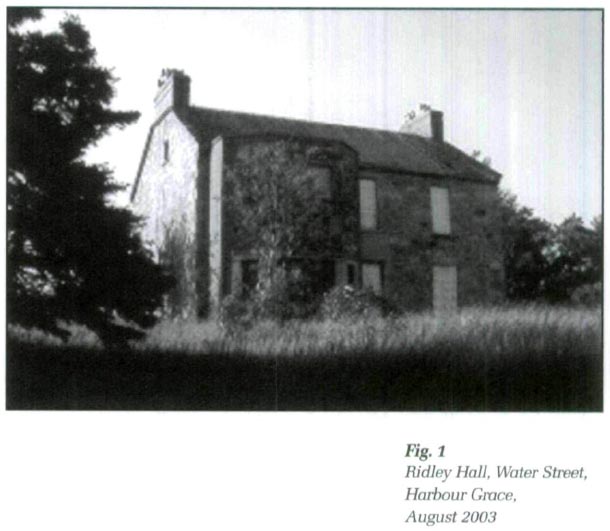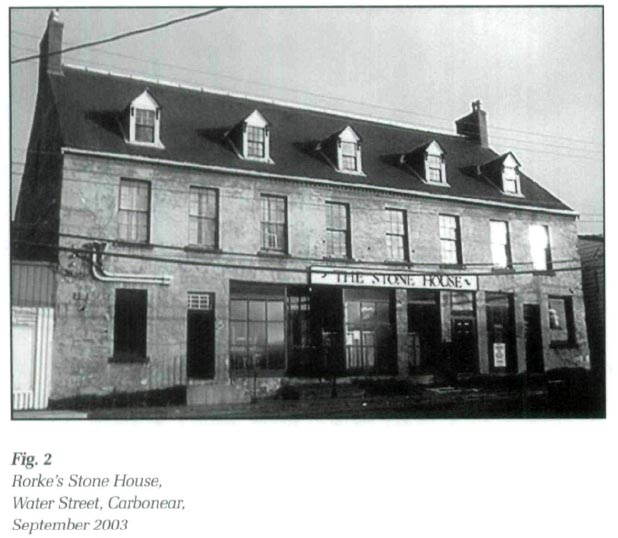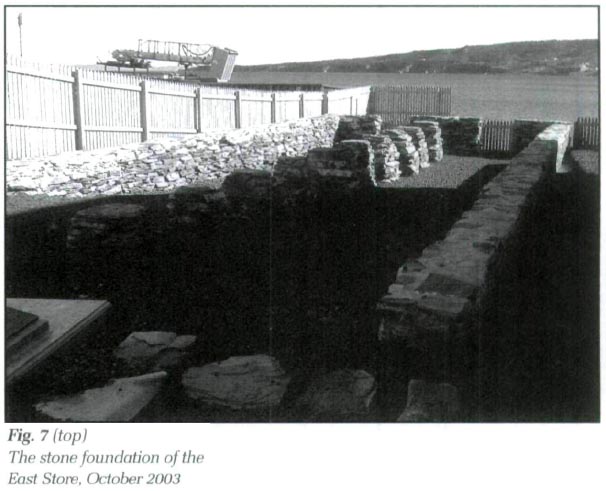Research Reports / Rapports de recherche
The Rorke Stores Museum:
"Balancing the Scales"
1 An Atlantic crossing from Athlone, Ireland, in 1824 would bring John Rourke, then seventeen years of age, to meet his fate and his fortune on the shores of Newfoundland. Rourke1 came to the small island country to work as an apprentice clerk in the Carbonear firm of Bennett and Ridley. William Bennett was young John's uncle and Thomas Ridley, his cousin.
2 In 1828, Ridley, a prominent and somewhat notorious merchant, struck out on his own and started his own firm in nearby Harbour Grace. In 1834 he constructed a grand stone home on Water Street, a structure that was henceforth known as "Ridley Hall." Complete with a grand ballroom and lush English gardens, Ridley Hall became a social haven for Harbour Grace elite. Schooners were known to salute the Hall as they passed through the Harbour and elaborate parties were hosted on the grounds.
3 The bank crash of 1894 left Ridley and countless others bankrupt and his home has changed hands several times throughout the last century.2 It served a tenure as a cable station and private estate in the early twentieth century, but has stood abandoned for at least the last two decades. The Hall is a prime target for vandalism, despite being purchased in 2003 by an Alberta couple who plan to gradually restore the building to its former grandeur. Overnight on Friday, 21 November 2003, intense flames emanated from the roof of the building, causing significant damage to the top floor, and smoke and water damage to the rest of the structure. While the cause is still under investigation, most observers point out that the building was a haunt for underage drinkers.
4 In this paper, I will tell of the history of two buildings in Carbonear — the "West Store" and the "East Store: — that on several occasions have come close to a similar destructive fate. The Rorke Premises were once a mill of activity; they were abandoned and now serve a prominent role in a community that has rediscovered them. In that process Carbonear has reclaimed a part of itself. We can only hope that Ridley Hall will benefit from such a revival.
5 John Rourke remained an associate of Bennett and Ridley for several years after his arrival in Newfoundland. He managed the firm's affairs in Adam's Cove, married the daughter of a Carbonear merchant, Mary Tocque, and returned to Carbonear. In 1838, Rourke acquired the old Slade and Elson premises on Water Street and established his own business in the Conception Bay town. With his mother-in-law Ann Tocque, he purchased and registered a 100-tonne vessel, the Elizabeth, and began a venture that would become one of the longest lived business enterprises in Newfoundland history. What evolved into the firm of John Rorke and Sons spanned 142 years and dealt in a myriad of fishery-related endeavours. The company had fishing rooms at St Francis Harbour and Venison Island, Labrador, and supplied stationers to ply the coast for codfish, salmon and herring each spring. The enterprise at Carbonear consisted of a dry goods store at the Stone House3 and Upper and Lower Rooms on Water Street. Besides being general dealers and having stakes in the fishery, John Rorke and Sons participated in the seal fishery, imported and sold coal from North Sydney, Nova Scotia, and had a shipping fleet that conducted international trade, sailing from Newfoundland to Europe and South America.
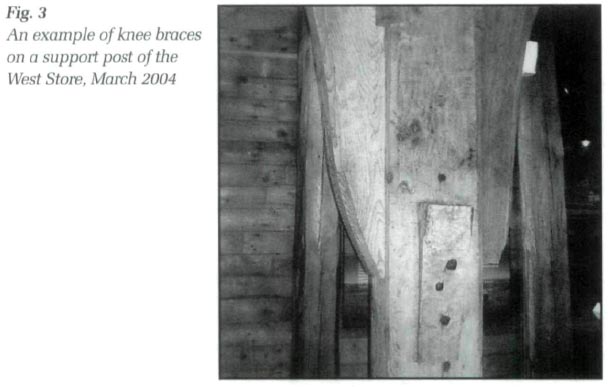 Display large image of Figure 3
Display large image of Figure 36 In 1874, Rorke expanded his holdings as his need for goods storage grew. Two structures were built on Water Street directly across from the Stone House to store much of the bulk goods the firm sold to the fishing families under their employ. The East Store was stocked mainly with foodstuffs such as salt pork, salt beef, and flour. Paint and animal feed were also available there. The West Store (also referred to as the "Molasses Store") was the place to go for any Carbonear resident wanting to have molasses kegs filled. It was also a storehouse for building materials, such as glass and cement, in addition to other supplies such as iron and lime.4 The first and second floors of each Store were used primarily for bulk storage, the third floor of the East building served as a twine loft (where fishermen would knit twine for nets) while the third floor of the West Store was a sail makers' loft. Many accounts given to the Rorke Store Research Project5 by older gentlemen of Carbonear refer to how on rainy or inclement days, young boys would gather in the lofts to "hear a yarn or two."6
7 Both of the Storehouses were constructed of pine that may have been harvested in nearby Green's Harbour, or arrived as ballast on ships. Each roof is covered in slate, most likely having the same origin of that found on the Stone House. What is perhaps most captivating about Rorke's Stores is their interior structure; externally they echo the standard design of Newfoundland fishing rooms (a design that is reflected in the new heritage super centre that is "The Rooms" complex in downtown St John's). The pine planks on the floor can only be described as massive, the largest floorboard measuring 56 cm across. The West Store has a balloon frame and a lock and key (or "scarf and key") construction, which "locks" the building's frame and gives it its structural integrity. The support posts are flanked with knee braces (or "ship's knees") that resemble the natural formation of a tree, the upward curvature of the braces mirroring the growth of roots.7 The Rorke Research Project team believes that the usage of ship's knees provides evidence that the building was constructed by the shipbuilders that were employed by John Rorke. The shipyard existed in the area that is now the parking lot for the Museum and was where the renowned shipbuilder Michael Kearney and his successor Richard Horwood did their work. A forge was present at some point in the shipyard, for the creation of hand forged or "rosebud" nails.
8 Great fires have been the bane of many Newfoundland communities, as evidenced repeatedly in St John's and Harbour Grace. Carbonear, too, has not been without its share of destruction by fire. Just as fire in 1859 had ruined the former Slade and Elson premises that Rorke took over, the East Store would meet the same fate in 1916. What is referred to locally as "Penney's Fire" came close to taking the West Store as well, as the two structures were so close in proximity. The West building came through unscathed, however, and Rorke promptly rebuilt another East Store with an identical exterior to its predecessor. The key difference between the first East Store and the one built to replace it was its structural design — it did not have a lock and key construction or knee braces. Rorke required storage space immediately, the new Store was put up quickly and these important elements were not incorporated into the new building. By 1917 construction on the new East Store was completed and it was in full operation. In the years that followed, a catwalk joined the East and West buildings and there was a wharf constructed directly behind the Stores where the Rorke vessels could dock and unload cargoes of salt, salted fish and dry goods to be sold at the Stone House.
9 Both Stores stood steadfast side-by-side for another 82 years, until once more the East Store was lost. John Rorke's descendants sold off the last of the business in Carbonear during 1979-1980 and ownership of the Stores was turned over to the town of Carbonear. They stood empty for some twenty years and pigeons gathered where iron men once did their day's work. A great number of business records lay boxed on the floors of both Stores and were collected by the Carbonear Heritage Society and donated to the Maritime History Archive at Memorial University. The Town stored items in the Stores and the Kinsmen ran a Haunted House in the West Store for several consecutive Hallowe'ens.
10 The Rorke mercantile premise was one of only three remaining in Newfoundland8 and was slowly deteriorating, despite being recognized as a registered heritage structure by the Heritage Foundation of Newfoundland and Labrador in 1988. Both Stores were subject to vandalism; when I was a child and had no concept of the grand history of the buildings I can recall the windows being repeatedly shattered by objects tossed through them. The buildings could easily have gone the way of Ridley Hall, and there were calls from some groups to have them demolished. On Sunday morning, 10 January 1999, I was informed by my mother (a committed volunteer with the Heritage Society who had been involved with a Steering Committee aiming for the restoration of both Stores) that the Rorke Shed had been blown down. A visit to the site produced feelings of disbelief and utter sadness. An intense windstorm was raging and the East Store had collapsed. Having been built in a hurry to meet the needs of the Company, the Store lacked the lock and key construction and knee braces of its sister building. It was simply not strong enough after years of neglect to stand up to the force of the winds.
11 The Steering Committee put in place to arrange a plan for the buildings mobilized quickly after the East Store collapse. Fortunately, the Store had not swayed in the direction of the West Store, but instead fell against the building on the opposite side, an insurance office. Considerable damage was done to the insurance office and they were forced to relocate to another space. Almost immediately crews were hired to remove what was left of the East Store and to stabilize the remaining building. Every wooden board and piece of slate from the demolished building was catalogued and placed in storage in the basement of the Stone House. This was done in the hope of someday rebuilding the East Store with much of its original material.
12 The destruction of the East Store, although tragic, provided the desperately needed catalyst to preserve one of the most important pieces of Carbonear history. Several benefits came out of the removal process: many artifacts were found in the ruins, and in the West Store, relating to the fishery and the trade that took place at the Stone House; and, the surplus of material from the East Store provided aged wood and slate to use in the stabilization of the West Store, providing a way to keep it truer to its original form. Rocks from an old root cellar were obtained and a rock wall and wooden fence and gate were built from the West Store to the neighbouring building. This provided protection for the exposed stone foundation of the East Store and allowed passers-by to view the ongoing work on the grounds from Water Street.
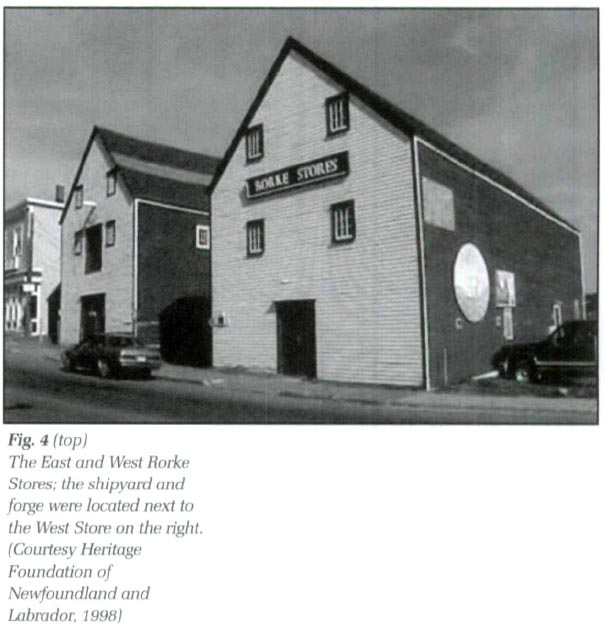 Display large image of Figure 4
Display large image of Figure 4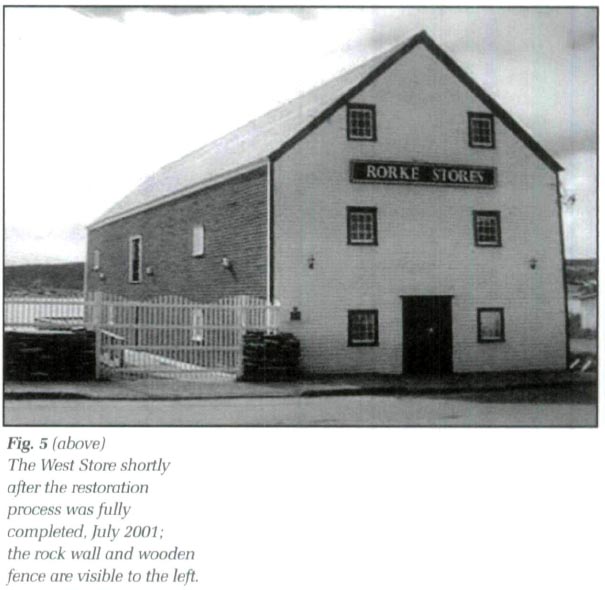 Display large image of Figure 5
Display large image of Figure 513 The Rorke Store Research Project team was assembled and opened an office across the street on the second floor of the Stone House. Carbonear history had been faded by familiarity; the buzz of activity on both sides of Water Street awoke a new and keen interest in many. A mission statement was adopted by the Project for the establishment of a Museum in the West Store. Interviewing began with many of the older members of the community who had been employed by the Rorkes and with members of the Rorke family. In addition, visits were made by the Research Project team to the Centre for Newfoundland Studies, the Maritime History Archive (both are located at Memorial University of Newfoundland, St John's campus) and the Provincial Archives of Newfoundland and Labrador in an effort to fill in many of the gaps. Much of the exhibit would be based on Carbonear's connection with the Labrador fishery, and would tell the stories of the stationers9 who spent their summers on Venison Island. The Museum would be dedicated not only to a merchant family, but also to the lives of those on whom they depended directly, their workers. The Research Project operated from 1999 until 2000 and the end result was a book, The Rorke Store Research Project: The Connection of the Fishery from Newfoundland to the Southeast Coast of Labrador, Circa 1874-1930s.10 From the information compiled in the book, storyboards could be drawn up that would also make use of the large number of photographs collected during the interviews.
14 The restoration of the West Store was a multi-step process. The West Store had become a pigeon coop, and this was problematic. Besides the reconstructive work, all artifacts found on site had to be cleaned, identified, and catalogued. Digital photographs were taken and stored in a database. All three floors of the structure had to be meticulously cleaned. Willing hands and forty cases of Murphy's Oil Soap cleansed each wooden board. Slate from the East Store replaced bad patches on the West. The company name, "John Rorke & Sons," had formerly been spelled out in a contrasting coloured slate on the roof of the East Store facing the harbour so that ships entering would be able it see it immediately. As Carbonear's business focus has shifted since the closure of the cod fishery and most of the business community now lies on the side opposite the harbour, the company name was moved to the roof of the West Store, facing what is referred to locally as "The Beach" (the main road connecting the business district with Water Street).
15 Recognizing that a Museum would require office space and public washrooms, material from the East Store was again incorporated into the front of the first floor. Two washrooms and two offices were built leaving a large and completely original exhibit space behind them. Two windows from the East Store were placed in the front of the first floor to give added natural light. Windows had been originally located in the same place but had been removed at some point after the 1950s. A large contemporary patio deck was built around the back of the building, allowing interpreters to show visitors the stone foundation of the East Store, and giving tourists the opportunity to sit and enjoy the view of the harbour and Carbonear Island, a National Historic Site. Stairs were constructed to provide ease of movement between the first and second floors.11 Under the stairs a closet encloses the new electrical system and sprinkler system panels. In 2002, an air conditioner was placed unobtrusively on the second floor sheltered from view by an enclosure of wood from the East Store. The new lighting in the building is soft and simple; in the first floor exhibit area track lighting shines on storyboards and display cases. On the second and third floors, bare bulbs illuminate without interfering with the tone of the building. Very little natural light comes in through the windows. The third floor is accessible only by ladder and like part of the second floor is reserved for storage. The walls of the third floor bear the carved names of many of the men employed by the Rorkes over the years.
16 The centrepiece of the entire building is of course its exhibit titled "Balancing the Scales." The name of the permanent exhibit is quite fitting and is explained on two storyboards at each entrance to the Store. The exhibit concept is the weaving of a story of the connection of the lives of a merchant family to their employees, "the fortunes of one depended entirely on the other."12 Marni Mahle, a former Carbonear resident, designed the exhibit in collaboration with the Rorke Store Research Project team. Her brother Kurt Mahle provided a scale model of Venison Island as it was in the early 1900s, and, the focal point for visitors as they enter—a life-size sculpture of two fishermen hoisting a fish barrow13 complete with authentic preserved salt cod, onto a set of scales found on site. The sculpture appears to be bronze but is actually a clever mix of papier-mâché and chicken wire.
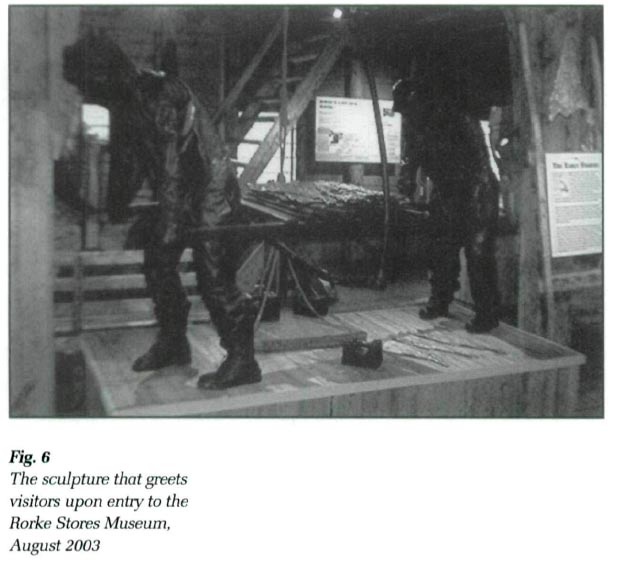 Display large image of Figure 6
Display large image of Figure 617 A guided tour of the Rorke Stores Museum begins upon entering the side entrance of the building. Storyboards line the walls and large bases built from wood from the East Store support display cases and various artifacts throughout the first floor. After a brief history of the Company, the visitor is lead to the back of the Museum, which is devoted entirely to Venison Island and Carbonear stationers and their families. A "grub box" (which would be packed with supplies for the family on their journey to Labrador) is surrounded with a number of typical tools and packing crates used by the stationers. The displays introduce the visitor to several stationer families via the storyboards' various anecdotes, providing a primer on the history of the region and the lives of its people. The large display cases in this section hold fishing implements and other items, including a bible owned by Hilda Mahaney,14 and a small wooden dory (a child's toy). Particular attention is paid to the work done on the Island by women and to the sense of family shared by the stationers. An enlarged mounted photograph of Venison Island taken by Robert Holloway in the late nineteenth or early twentieth century wraps around the corner of this section. Coils of hand twisted rope that were found on the upper floors, cleaned and made ready for display, are located on the floor underneath the Holloway photograph. The rope sits next to the largest block and tackle that was found on site. A large metal cask that is still partially full of linseed oil, a staple that sailors used to waterproof cloth and preserve sails, is displayed in this area. A reproduction fish flake lies in the opposite corner and is covered in lacquered salt fish laid "heads-to-tails" as it would have been for drying.
18 The interpreters who worked at the Store in its first summer of operation in 2001 had a hands-on history lesson as we hard dried the salt cod that were used in the exhibit. Each morning the fish would be spread on the stone foundation of the East Store and would be turned several times throughout the day until the desired effect was achieved. A donated splitting table, grapple and net are located on top of the fish flake. An impressive winch worn with rope burns is located under the original stairs, and it was used to lower bulk goods from the second floor to the first floor when the Stores were in full operation. A bench is provided for visitors to sit and watch a 22-minute CBC Land and Sea documentary,15 made in 2000 at the urging of the Rorke Store Research Project, that focuses on the last of the Carbonear stationers and their experiences on Venison Island.
19 After a short trip outside to explain the history of the Stone House, the East Store and its stone foundation and the iron anchor monument,16 visitors are introduced to the Honourable John Rorke.17 The front section of the exhibit is devoted to the Rorke family history, the Stone House, the shipyard, the cooperage run at Venison Island and the sail loft. Members of the Rorke family have donated a number of items to the Museum, including the ledger desk, wooden filing cabinet and safe from the Stone House, that are located in this area of the exhibit. Additionally, various advertising materials that were posted in the Stone House are found here. The most vulnerable artifacts are situated in this section: paper shipping records and ledgers, the Rorke company flag and "Union Jack" that was flown on every Rorke vessel, a hooked rug depicting the Rooms at Venison Island and presented to the Rorkes as a gift,18 a 100-year-old top hat and shirt collars that were owned by John Rorke H. A large display case that was donated by Leslie Nurse (formerly used in Hawker's store, a Carbonear merchant firm that operated on Water Street and closed in the 1980s) houses small artifacts including an atomizer used by John Rorke II and a model of Rorke's schooner, the Kate.
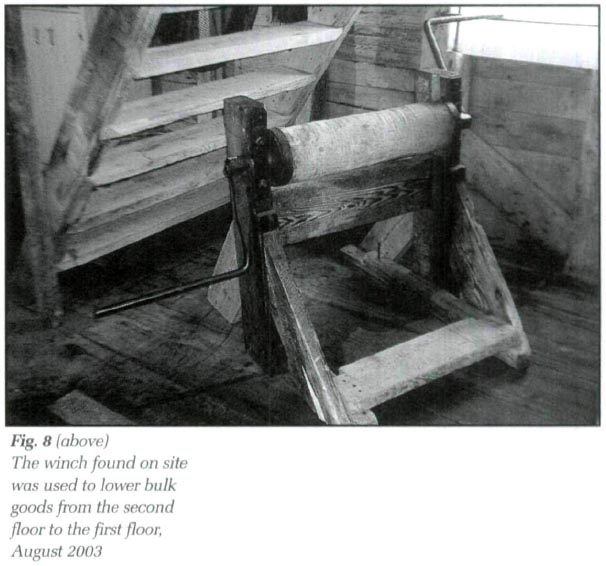 Display large image of Figure 8
Display large image of Figure 8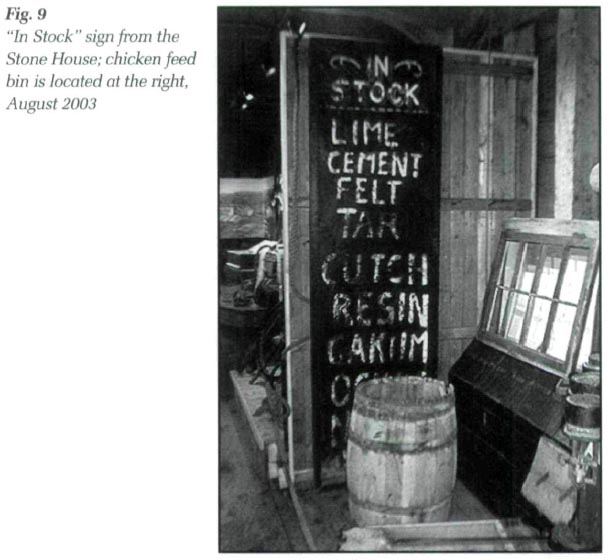 Display large image of Figure 9
Display large image of Figure 9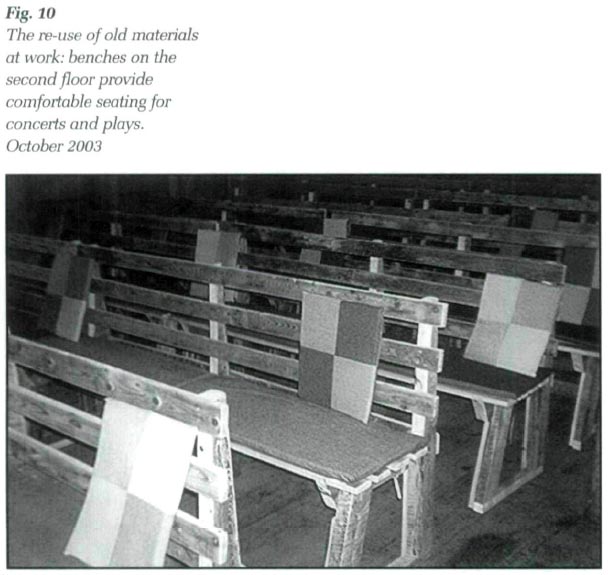 Display large image of Figure 10
Display large image of Figure 1020 Another part of a scale found on site holds rope to enclose a section incorporating a chicken feed bin that was used in the Stone House, scales for weighing bulk goods and the cooperage display, which is complete with a set of cooper's tools donated by the Garland family. A "mutton-chop" sail and a ship's wheel from a Rorke vessel bring the visitor back to the beginning of the exhibit. By the door is perhaps the most unusual piece in the exhibit — a headstone. The headstone was formed in the East Store and was used in a Rebel Island Theatre production of Al Pittman's West Moon. Because of its unwieldy size it has not been moved since being returned to the West Store. During the summer of 2003, a visitor informed us that the two persons listed on the headstone were the father-in-law and sister-in-law of John Rorke III. The top of the headstone is damaged and we believe that it was brought to the Store to be shipped out for repairs, but for some reason was overlooked.
21 There are a number of iron pieces throughout the Museum and each piece was conserved under the instruction of the Provincial Museum of Newfoundland and Labrador. The iron anchor, which had been underwater for an undetermined amount of time, was treated under the advisement of marine conservators. The conservation process for every artifact at the Museum allowed local people employed with the restoration project to gain invaluable skills in this area. For the most part the collection is stable; the Museum however, is located in an old warehouse and seasonal temperature and humidity fluctuations are a concern that are perhaps not being addressed to the level that they could be.
22 While I did have a tiny mouse run out under my feet while giving a guided tour this past summer, pests are not a major concern at the Rorke Stores Museum. The Store is located less than ten feet away from the shoreline, so rodents are expected but are not a noticeable problem. Since the pigeons have moved on, there has been no difficulty with them. Moths and other insects have, thankfully, not inflicted any damage to the collection thus far. Being located across the street from a pub can periodically be a challenge, but aside from an occasional broken bottle in the parking lot or on the cobblestones at the front of the building, the past three years have been relatively incident free. Two small suspicious fires broke out in August 2003. An electrical problem was ruled out and an official cause has not been released. The first fire was very minor and no damage was caused. A second erupted from under the new stairwell and was quickly put out by the Carbonear Volunteer Fire Department. The stairs are located near the offices and the wash-rooms and completely away from the collection, so no harm was done. A few boards were replaced and some cleaning was required, closing the Museum for two days. It provided a wake-up call and all interpretive staff is now better educated about fire safety, and, more fire extinguishers were installed in numerous locations throughout the building. When dealing with a very old wooden structure, one can never be too cautious.
23 The building is quite large and all parties involved recognized the need for the building to hold more than an exhibit space. The Museum opened its doors in July 2001 and the second floor's usage has evolved since that time.It is referred to as "The Loft" and is made available for occasional traditional music sessions. Past concerts have included performances by Pamela Morgan, Jenny Gear and the Whiskey Kittens and fiddler Danette Eddy. Rebel Island Theatre, a Carbonear-based company, makes best use of the space during their summer Theatre Festival each year. In 2001, Stars in the Sky Morning was staged there; in 2002, Stars returned and was accompanied by Judge Prowse Presiding. Therese's Creed and Quiller enthralled audiences twice a week in 2003 as did Turncoat Hill in 2004. After the first year's productions, a need was determined for permanent seating. Wood from the East Store was again used to build benches, and Rebel Island's seamstresses fitted each bench with comfortable padding the following year.
Mary Pratt
13 December 1999
Carbonear grew around its harbour since being settled in the mid seventeenth century. 130 years after its construction by shipbuilders, Rorkes Room stands tall against an increasingly modernized seascape. Generations of Carbonear residents have worked for the Rorkes, in the Stores, in the shipyard, at the Stone House and sailing ships the world over. Before the shopping complexes of the late 1970s and 1980s were built across town, merchant firms on Water Street supplied a community. The town of Carbonear owes much to these family firms who fashioned its economy. The Rorke Store Museum could not have been established without the continued assistance and total financial support of the town of Carbonear. Tourists who travel to Carbonear during the summer months continue to influence the town's economic growth. The Museum and the town are inextricably linked; just as the fortunes of the merchant and the worker depended on each other in Rorke's heyday, the same can now be said for a town and its Museum.
The Rorke Stores Museum was the recipient of a 2004 Newfoundland Historic Trust Southcott Award (awarded "to recognize excellence in the preservation of the architectural heritage of Newfoundland and Labrador.")
